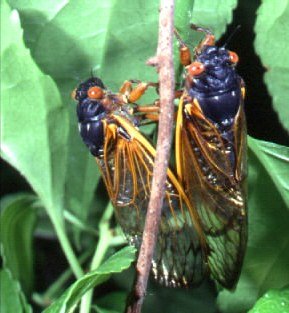|
Periodical Cicada
View more pictures: Bing Images Google Images Yahoo Images Common names: Periodical Cicada Scientific name: Magicicada septendecim Region: This insect is found in the eastern and southeastern United States. Life cycle: The Cicada requires 13 to 17 years to complete its life cycle, where they exist under the ground as nymphs until they become adults and emerge. Physical description: This 1 1/2 inch long insect is brown or black with orange legs and eyes, and has transparent wings that are long and wedge shaped. It is often mistakenly called a locust. The eggs are laid and placed in slits made in the bark of trees and twigs. The nymph is small and resembles a brown ant when is young, but later grows forming a stout body and is brown or blackish. Feeding characteristics: This pest will attack fruit trees, such as apple, by chewing the roots as nymphs and the adults will suck the sap from the limbs and twigs. While their eating habits rarely do serious damage to the trees, they can devastate new plantings with its egg-laying punctures. The stitching on small shoots or twigs will weaken them to the point that a small amount of pressure can cause them to break. Controls: There isn't much you can do about preventing their emergence, but fortunately it's only every 17 years. You should try to avoid planting in years that they are expected in your area. For established trees, promptly remove the injured twigs and destroy them. Periodical Cicada |
